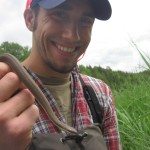Ontario Nature Blog
Receive email alerts about breaking conservation
and environmental news.
© Lora Denis
Northern ribbonsnake © Joe Crowley
Thirty years ago, hundreds of naturalists, biologists and outdoorsmen in Ontario began archiving hundreds of thousands of reptile and amphibian observations. Twenty-five years later, Ontario Nature continued and expanded that data collection to the entire province.
The organization, which receives tens of thousands of additional records each year, is currently sitting on over 431,000 records of reptile and amphibian observations, each kept in the aptly named Ontario Reptile and Amphibian Atlas (ORAA).
Some people think that almost half a million records is enough, but is it? Many experts see widespread species declines in ORAA data, but is it a case of species decline or a shortage of reported observations?
To investigate, we examined ORAA data for snakes. We divided Ontario into a grid of 10 by 10 kilometre squares, and looked at all the snakes found in those squares. Snakes were recorded in over 1,000 of these squares, but often to a limited degree. About 70 percent of the squares only had reports of one or two species out of the 18 snake species found in the province.
We wondered if this was indicative of a lack of species or a lack of observations. To explore this, we developed the Total Snake Index (TSI), which is basically the number of snakes you need to find in one square before you find your target snake. We calculated a TSI for each species in each square, and the results gave us a rough answer to our over-riding question: Is the problem a shortage of species of a shortage of observations?
Let’s look at the eastern ribbonsnake as an example. Knowing the TSI for this species for many squares allows us to determine that many squares have not been surveyed enough. This is true for many species and squares. In fact, we estimate that only 10 to 20 percent of squares have been surveyed enough to conclude “shortage of species”. The rest of the squares have a shortage of observations. In the near future, Ontario Nature will add a TSI layer in the ORAA range maps for those that are interested. TSI queries can be sent to atlas@ontarionature.org.
Remember to submit all your reptile and amphibian sightings to the atlas. Your efforts contribute to policy-changing research underway in Ontario and across Canada.
This blog was written by James Patterson and Dave Seburn.

James Paterson is a PhD student at the University of Ottawa. His research focuses on the habitat selection, conservation biology and ecology of reptiles. View his previous blog here.

David Seburn is an ecological consultant specializing in species at risk. He is both an Ottawa area coordinator and a provincial steering committee member of the Ontario Reptile and Amphibian Atlas. View his previous blog here.
Gananoque Lake Nature Reserve © Smera Sukumar